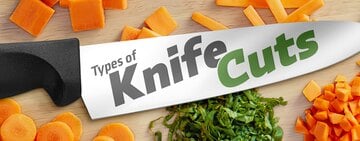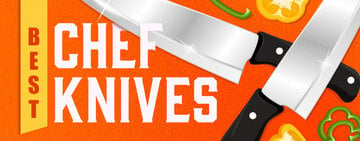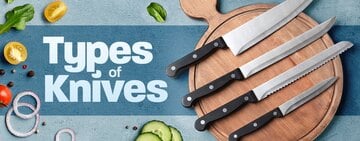Cleaning a knife may seem like a simple task, but it is crucial to do it safely and effectively to maintain its sharpness and longevity. Whether you are a professional chef or a home cook, understanding the proper techniques for cleaning knives is essential. We’ll guide you through the process of safely cleaning knives, providing you with valuable tips and best practices to keep your knives in optimal condition. By following these guidelines, you can ensure that your knives remain sharp, free from bacteria, and ready for use in your commercial kitchen.
Shop all Chef KnivesHow to Clean a Knife

Your knives play a key role in the success of your recipes. Keep them clean, sharp, and ready for any culinary task by following these simple steps:
- Hold by the Handle: When it comes to cleaning a knife, safety should always be the top priority. To avoid knife accidents or injuries, make sure to hold the knife by its handle throughout the cleaning process, keeping the point angled away from your body. This will help you maintain a firm grip and prevent any accidental slips or cuts.
- Carefully Scrub: Use gentle dish soap and a non-abrasive sponge or brush to remove any food particles, stains, or residue from the blade. Slowly and carefully work around the sharp edge to ensure that all food particles are cleaned off. For additional safety, lay the blade flat to wipe each side to prevent injuries.
- Rinse with Water: After scrubbing, rinse the knife under running water to remove any soap or cleaner residue. Rinse both sides of the blade and the handle thoroughly.
- Dry Immediately: To prevent any rust or corrosion, it's important to dry the knife immediately after rinsing. Use a clean towel or paper towel to carefully dry the blade and handle, making sure to reach all the nooks and crannies. Avoid air-drying the knife, as this can leave moisture behind and dull the blade.
- Store Safely: Once the knife is completely dry, it's time to store it safely in a knife block, knife sleeve, or on a magnetic strip, where it can be protected from damage and kept within easy reach.
Knife Cleaning Tips
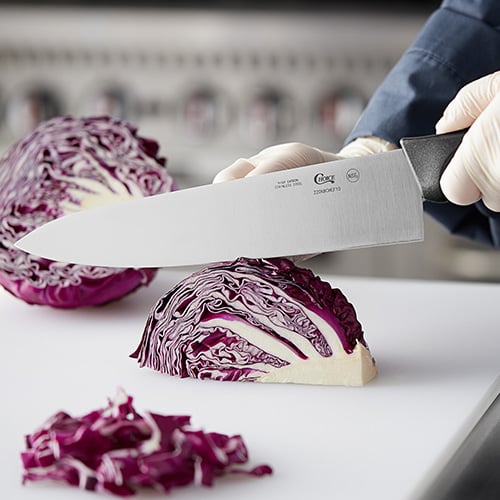
Here are a few knife-cleaning tips to help you keep your blades in top shape and prevent accidents during the process:
- Wash Knives by Hand: While it may be tempting to throw your knives in the dishwasher, it's best to wash them by hand. Dishwashers can cause the blades to bang against other utensils, potentially dulling the edge or causing chips. Additionally, the high heat and harsh detergents used in dishwashers can damage the knife's handle and blade.
- Clean Knives Immediately after Use: It's important to clean your knives right after using them, especially if they have come into contact with acidic or corrosive foods. Acidic substances like lemon juice or vinegar can cause the blade to tarnish or rust if left on for an extended period. By cleaning your knives promptly, you can prevent any potential damage.
- Use a Sponge or Brush: When cleaning your knives, opt for a non-abrasive sponge or a soft-bristled brush. These tools are gentle enough to clean the knife thoroughly without scratching or damaging the blade or handle. Avoid using steel wool or abrasive cleaners as they can leave scratches and compromise the knife's integrity.
- Soak Stuck-on Food: If you encounter stubborn, stuck-on food residue on your knife, soaking it in warm water can help loosen the debris. Fill a sink or basin with warm water and a mild dishwashing detergent. Place the knife in the soapy water and let it soak for a few minutes. This will help soften the residue, making it easier to clean off.
- Never Leave Knives in the Sink: It may be tempting to drop a knife in the sink to soak, but this can be dangerous and bad for your knives. Not only are knives prone to rusting, but they can end up cutting a dishwasher as they reach into the basin, unaware that a sharp object is in there.
Storing Knives after Cleaning
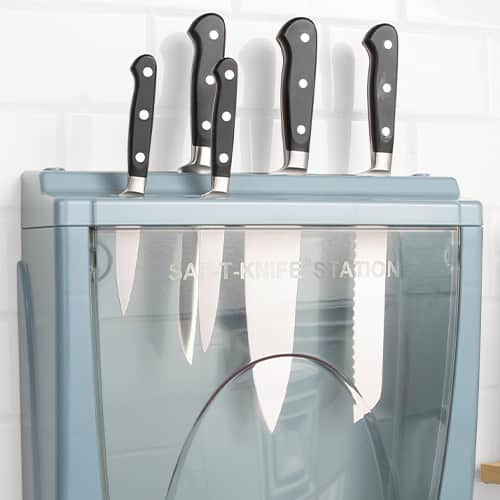
Investing in proper knife storage is crucial for maintaining the performance and lifespan of your knives. By utilizing one of these storage options, you can keep your knives organized, easily accessible, and well-protected.
- Knife Blocks: A knife block is a classic storage solution that keeps your knives organized and readily accessible. It typically features slots of different sizes to accommodate various knife types and sizes. The block's design not only protects the blades but also prevents accidental cuts. Additionally, the block's weight ensures stability and prevents it from tipping over.
- Knife Racks: Knife racks are another popular storage option, especially for commercial kitchens with limited counter space. These racks are usually mounted on the wall or under cabinets and feature magnetic strips or slots to securely hold the knives. Knife racks provide convenient access to your knives while keeping them off the counter, reducing clutter and promoting safety.
- Knife Sleeves: A knife sleeve is a simple yet effective storage solution that protects your knives from damage and keeps them safely stored. Made of durable materials like nylon or plastic, knife sleeves are designed to cover the entire blade, preventing accidental cuts and preserving sharpness. They are easy to use and ideal for chefs who frequently travel or need to transport their knives.
- Magnetic Knife Holders: Magnetic knife holders are a modern and stylish storage option. These holders feature strong magnets that securely hold the knives in place, allowing for easy access and visibility. Magnetic knife holders can be mounted on walls or under cabinets, saving valuable counter space.
- Knife Bags: Knife bags are a portable storage solution for chefs who need to transport their knives. These bags typically have individual compartments or slots for each knife, keeping them organized and protected. Knife bags are often made of durable materials like nylon or canvas and feature handles or shoulder straps for easy carrying.
How to Remove Rust from Knives
Rust can easily develop on knives, especially if they are not properly maintained. To remove rust from a knife, start by scrubbing the affected area with a mixture of baking soda and water using a soft brush or cloth. For stubborn rust, a mixture of vinegar and lemon juice can be applied and left to sit for a few minutes before scrubbing. Another effective method is to soak the knife in a solution of white vinegar and water for a few hours. After removing the rust, be sure to thoroughly dry the knife to prevent further corrosion.
Can Knives Go in the Dishwasher?
While it may be tempting to toss your knives in the dishwasher for a quick and easy clean, it is not recommended. The high heat and harsh detergents used in dishwashers can cause the knife blades to become dull and corroded over time. Additionally, the agitation and movement inside the dishwasher can cause the knives to bang against other utensils, potentially damaging the blade or handle. To keep your knives in top condition, it is best to hand wash them with mild soap and warm water and then dry them thoroughly before storing them.
Sharp knives can be tricky to handle in a commercial kitchen. By following a few simple steps, you can effectively clean and sanitize your knives to ensure food safety in your kitchen and maintain the longevity of the blades. Remember to keep your knives sharp and clean for the best results.

